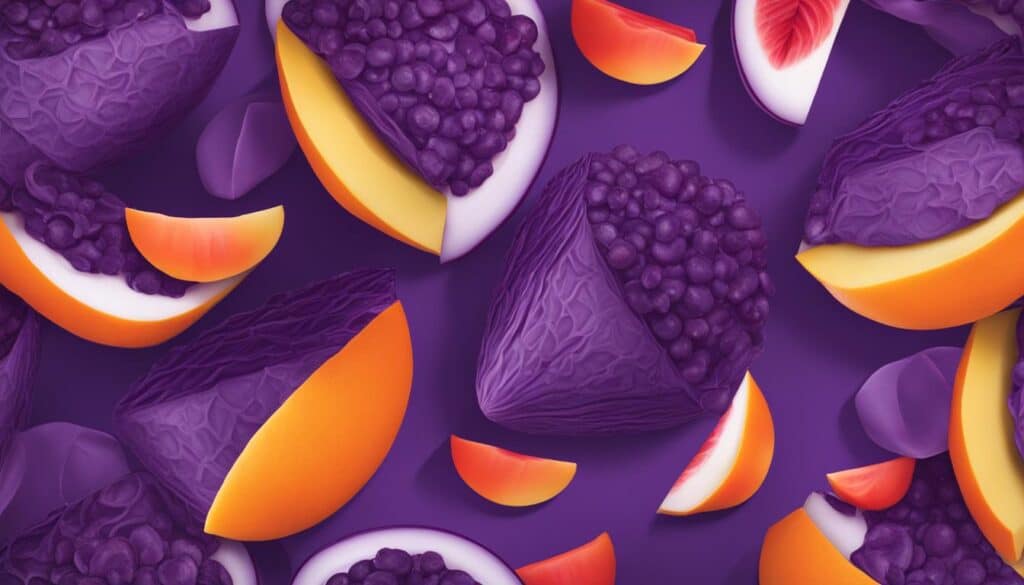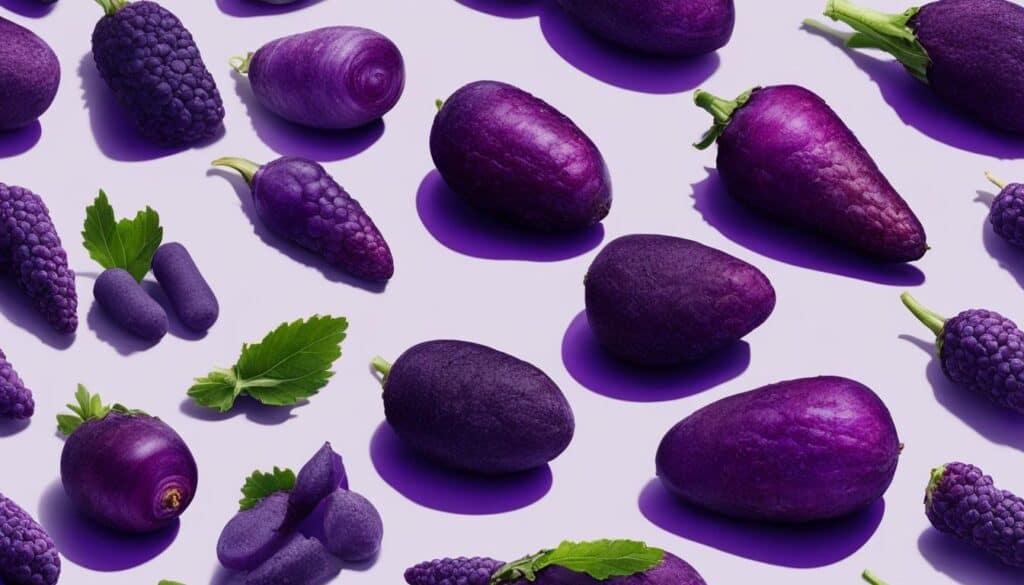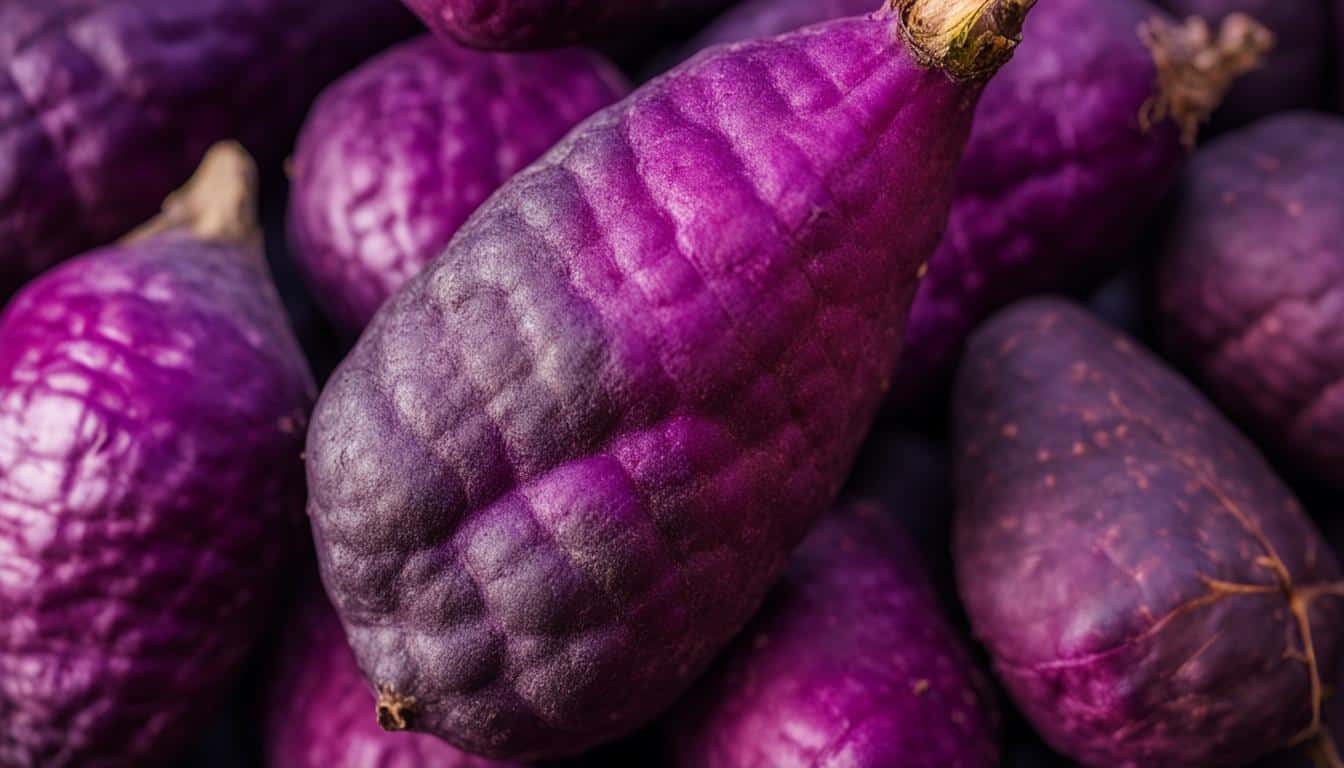Are you ready to embark on a culinary adventure and discover the vibrant flavors of Filipino produce? Look no further than the ube fruit, also known as the purple yam! This root vegetable is not only visually stunning with its deep purple hue but also offers a unique taste that is both sweet and nutty. Originally popular in Southeast Asia, particularly the Philippines, ube has now captivated taste buds all around the world.
- Ube is a versatile root vegetable with a vibrant purple color and a distinct sweet and nutty taste.
- Originating from the Philippines, ube is now enjoyed worldwide and is considered a superfood due to its high content of antioxidants, vitamins, minerals, and fiber.
- Ube is a nutritious powerhouse, providing essential nutrients such as potassium, vitamin C, and anthocyanins, which have been linked to various health benefits.
- Consuming ube may help regulate blood sugar levels, lower blood pressure, promote respiratory health, and support gut health.
- Ube is incredibly versatile in the kitchen and can be used in both sweet and savory dishes, making it a favorite ingredient among chefs and home cooks alike.
The Nutritional Powerhouse of Ube
When it comes to nutrition, ube, also known as the purple yam, is a true powerhouse. This vibrant root vegetable is not only packed with flavor but also loaded with essential nutrients that contribute to overall health and well-being.
One cup of cooked ube contains approximately 140 calories, 27 grams of carbohydrates, 1 gram of protein, and just 0.1 grams of fat. Despite its low fat content, ube is a great source of energy due to its high carbohydrate content. In addition to being a good source of energy, ube is also rich in important nutrients like potassium and vitamin C.
Table: Nutritional Content of Ube
| Nutrients | Amount per cup (cooked) |
|---|---|
| Calories | 140 |
| Carbohydrates | 27 grams |
| Protein | 1 gram |
| Fat | 0.1 gram |
| Potassium | 13.5% of daily value |
| Vitamin C | 40% of daily value |
Ube is particularly noteworthy for its potassium content, providing about 13.5% of the daily value per cup. Potassium is an essential mineral that plays a vital role in maintaining proper heart and muscle function. Additionally, ube is an excellent source of vitamin C, which is known for its immune-boosting properties and its role in collagen production.
Furthermore, ube is rich in antioxidants, including anthocyanins, which give it its distinct purple color. Antioxidants help protect the body against oxidative stress and may reduce the risk of chronic diseases such as cancer and heart disease. The combination of its vibrant color and impressive nutritional profile makes ube a standout ingredient that can truly elevate your health and well-being.
The Impressive Antioxidant Benefits of Ube
Ube, also known as purple yam, is not only a delicious and versatile ingredient but also a powerhouse of antioxidants. These antioxidants, such as anthocyanins and vitamin C, play a crucial role in protecting our cells from free radical damage and reducing the risk of chronic diseases like cancer.
Anthocyanins, the pigments responsible for the vibrant purple color of ube, have been shown to have potent antioxidant properties. They help neutralize harmful free radicals in the body, preventing oxidative stress and cell damage. Research has also linked anthocyanins to a reduced risk of several types of cancers, including colon, lung, and prostate cancer.
Vitamin C, another antioxidant found abundantly in ube, also contributes to its protective effects against cell damage and cancer. Studies have shown that consuming more vitamin C can increase antioxidant levels in the body and help fend off oxidative stress. Including ube in your diet can be a simple and delicious way to boost your antioxidant intake and support your overall health.
The Antioxidant Content of Ube Compared to other Foods
| Food | Antioxidant Content (per 100g) |
|---|---|
| Ube | 1500 units |
| Blueberries | 400 units |
| Spinach | 1200 units |
| Dark Chocolate | 900 units |
As you can see from the comparison table above, ube stands out as a rich source of antioxidants. Its antioxidant content surpasses that of popular antioxidant-rich foods like blueberries, spinach, and dark chocolate. Incorporating ube into your diet can help boost your overall antioxidant intake and provide additional protection against cell damage and chronic diseases.
Ube and Blood Sugar Control

The consumption of ube, or purple yam, has been associated with several potential health benefits, including its impact on blood sugar control. Flavonoids found in ube have shown promise in helping to lower blood sugar levels, particularly in individuals with type 2 diabetes. These bioactive compounds have been found to reduce oxidative stress and improve insulin resistance, leading to improved blood sugar regulation.
Furthermore, the glycemic index of ube is relatively low, which means that its carbohydrates are broken down slowly in the body, resulting in a gradual release of energy and a more stable blood sugar level. This is particularly beneficial for individuals who need to manage their blood sugar levels, as it helps prevent sudden spikes and crashes that can impact overall health and well-being.
It is important to note that while ube can be a helpful addition to a blood sugar-friendly diet, moderation is still key. The overall composition of a meal or snack, including the combination of various macronutrients, plays a significant role in blood sugar control. It is always advisable to consult with a healthcare professional or registered dietitian for personalized guidance on incorporating ube into a balanced and individualized meal plan.
| Food | Glycemic Index (GI) |
|---|---|
| Ube (Purple Yam) | 35 |
| Sweet Potato | 63 |
| White Rice | 73 |
| Whole Wheat Bread | 69 |
“Incorporating ube into a balanced and healthy diet can be a delicious way to support blood sugar control. Its natural sweetness and low glycemic index make it a great alternative to higher glycemic foods when managing blood sugar levels.” – Registered Dietitian
Ube and Blood Pressure Regulation
When it comes to maintaining healthy blood pressure levels, incorporating ube into your diet may offer some benefits. Ube is packed with antioxidants, which have been shown to have blood-pressure-lowering effects. Studies have found that the antioxidants in ube can work similarly to ACE inhibitors, a common class of medications used to treat high blood pressure. While more research is needed to fully understand the impact of consuming ube on blood pressure regulation, the initial findings are promising.
Antioxidants play a crucial role in protecting our cells from damage caused by free radicals. By reducing oxidative stress and inflammation, antioxidants help promote overall cardiovascular health. Ube’s vibrant purple color is a testament to its high antioxidant content, particularly anthocyanins. These compounds have been associated with improved blood vessel function and reduced risk of cardiovascular diseases.
Incorporating ube into your diet can be as simple as enjoying ube-based desserts or adding cooked ube to savory dishes. It’s important to note that while ube may contribute to blood pressure regulation, it should not replace prescribed medications or medical advice. If you have high blood pressure or any cardiovascular concerns, it’s always best to consult with your healthcare provider for personalized recommendations and guidance.
| Benefits of Ube for Blood Pressure Regulation |
|---|
| High in antioxidants, such as anthocyanins |
| Promotes overall cardiovascular health |
| May have blood-pressure-lowering effects |
| Should not replace medical advice or prescribed medications |
Ube and Respiratory Health
When it comes to respiratory health, incorporating ube into your diet may have some surprising benefits. The antioxidants found in ube, particularly vitamins A and C, have been linked to reduced asthma symptoms and lower risk of developing asthma. These essential vitamins play a crucial role in maintaining a healthy respiratory system.
A study published in the Journal of Allergy and Clinical Immunology found that individuals with higher vitamin A and C levels had a lower incidence of asthma. The study concluded that increasing the intake of these vitamins could potentially benefit respiratory health and reduce the risk of asthma.
To increase your intake of vitamins A and C, you can incorporate ube into your meals and snacks. Whether it’s enjoying a slice of ube cake or adding mashed ube to your smoothies, this vibrant purple root vegetable can provide a delicious and nutritious boost to your respiratory health.
| Ube Fruit (per 100g) | Vitamin A (IU) | Vitamin C (mg) | |
|---|---|---|---|
| Raw Ube | 82 calories | 25 IU | 0 mg |
| Cooked Ube | 103 calories | 30 IU | 0 mg |
| Frozen Ube | 106 calories | 53 IU | 0.3 mg |
As seen in the table above, ube contains small amounts of vitamin A and C. While it may not be the highest source of these vitamins, incorporating ube into a balanced diet alongside other vitamin-rich foods can contribute to overall respiratory health and well-being.
Ube and Gut Health
When it comes to promoting gut health, ube, also known as the purple yam, has some impressive benefits. One of the key reasons for its gut-friendly properties is its content of resistant starch. Resistant starch is a type of carbohydrate that is not easily digested in the small intestine, instead reaching the large intestine intact. Once it reaches the large intestine, it serves as food for the beneficial bacteria that reside there, promoting their growth and activity.
The presence of these beneficial bacteria in the gut is essential for maintaining a healthy digestive system. They play a crucial role in breaking down complex carbohydrates and fiber, aiding in the production of short-chain fatty acids, which provide energy to the cells lining the colon. Additionally, these short-chain fatty acids have anti-inflammatory effects, helping to reduce gut inflammation and support overall gut health.
Studies have also suggested that the anti-inflammatory effects of ube may extend to the gut. Animal studies have shown that ube extract has anti-inflammatory properties, which could potentially benefit individuals with conditions such as colitis. However, more research is needed to fully understand the extent of these effects and how they may translate to human health.
The Role of Ube in Gut Health
Overall, incorporating ube into your diet can be a delicious way to support gut health. Its resistant starch content promotes the growth of beneficial bacteria, while its anti-inflammatory effects may provide additional benefits to the gut. However, it’s important to note that individual responses to ube may vary, and it’s always best to listen to your body and consume it in moderation as part of a balanced diet.
| Ube and Gut Health | Summary |
|---|---|
| Resistant starch in ube promotes the growth of beneficial bacteria in the gut. | Supports a healthy digestive system and breakdown of complex carbs and fiber. |
| Ube’s anti-inflammatory effects may help reduce gut inflammation. | Potential benefits for individuals with conditions such as colitis. |
| Individual responses to ube may vary, and moderation is key. | Enjoy ube as part of a balanced diet for optimal gut health. |
Ube’s Versatility in the Kitchen

Ube, also known as the purple yam, is not only a nutritious superfood but also an incredibly versatile ingredient in the kitchen. Its vibrant purple color and unique flavor make it a popular choice in both sweet and savory dishes. From traditional Filipino desserts to creative innovations, there are endless possibilities when it comes to cooking with ube.
In Filipino cuisine, ube is commonly used to create delicious desserts such as cakes, puddings, flan, and cheesecakes. Its natural sweetness and nutty flavor add a delightful taste to these treats. But the culinary uses of ube don’t stop there. It can also be boiled, mashed, fried, or baked, offering a range of textures and tastes.
The Versatility of Ube in Different Dishes
Ube adds a vibrant pop of color when used in savory dishes as well. It can be incorporated into soups, stews, and even savory pies, adding both a visual appeal and a unique flavor profile. The versatility of ube allows chefs and home cooks to get creative in the kitchen, exploring new recipes and experimenting with different combinations of ingredients.
Whether you’re looking to satisfy your sweet tooth or create a savory masterpiece, ube is a fantastic ingredient to have in your culinary repertoire. Its versatility opens up a world of possibilities, allowing you to explore the endless flavors and textures that can be created with this purple yam.
| Dish | Culinary Use |
|---|---|
| Ube Cake | A popular Filipino dessert made with ube-flavored sponge cake layers and ube frosting. |
| Ube Halaya | A sweet and creamy dessert made from mashed ube, coconut milk, sugar, and butter. |
| Ube Leche Flan | A twist on the classic custard dessert, combining the flavors of ube and caramel. |
| Ube Bread | Soft and fluffy bread infused with ube flavor, perfect for breakfast or snacks. |
Ube vs. Taro Root: What’s the Difference?

Ube and taro root are often confused due to their similar appearance, but they are distinct from each other. Ube is a purple yam, while taro root is a different root vegetable originating from the taro plant. Taro is commonly used in savory dishes, while ube is primarily used in sweets. Although they share some similarities, they have their own unique flavors and culinary applications.
To understand the differences between ube and taro root, let’s take a closer look at their characteristics:
Ube
- Origin: Southeast Asia, particularly the Philippines
- Color: Vibrant purple
- Taste: Sweet and nutty
- Texture: Smooth and starchy
- Common Culinary Uses: Desserts like cakes, puddings, flan, and cheesecake; also used in candy, jams, and drinks
Taro Root
- Origin: Southeast Asia, India, and China
- Color: Light beige or brown skin with white or purple flesh
- Taste: Mild and nutty
- Texture: Slightly fibrous and starchy
- Common Culinary Uses: Savory dishes like soups, stews, and curries; also used in chips and dumplings
While both ube and taro root are versatile and flavorful ingredients, they each bring their own unique qualities to the table. Whether you’re indulging in a rich slice of ube cake or savoring a comforting bowl of taro soup, these distinct root vegetables offer a delightful range of culinary experiences.
| Ube | Taro Root |
|---|---|
| Purple color | Beige or brown skin with white or purple flesh |
| Sweet and nutty taste | Mild and nutty taste |
| Smooth and starchy texture | Slightly fibrous and starchy texture |
| Used in sweets like cakes, puddings, and jams | Used in savory dishes like soups, stews, and curries |
So, the next time you come across a purple-hued treat or a delightful taro-infused dish, you’ll know whether it’s ube or taro root that’s tickling your taste buds!
Ube’s Rise in Popularity
Ube, also known as the purple yam, has seen a surge in popularity in recent years, particularly on social media platforms like Instagram and TikTok. Its vibrant purple color and unique flavor have made it a favorite among food bloggers and culinary enthusiasts. The visually stunning dishes created with ube have become a viral sensation, leading to a widespread fascination with this versatile ingredient.
The rise in popularity of ube can be attributed to the growing interest in Filipino cuisine and its incorporation into various desserts and dishes by restaurants and bakeries. Ube-flavored treats like cakes, ice cream, and pastries have become a hot culinary trend, appealing to those seeking new and exciting flavors.
The allure of ube lies not only in its visual appeal but also in its rich cultural heritage. As more people become aware of the Filipino roots of this vibrant purple yam, they are eager to explore and celebrate its flavors in their own culinary creations. Ube is no longer confined to traditional Filipino dishes; it has become a global sensation, captivating taste buds around the world.
The growing popularity of ube is expected to continue, as chefs and home cooks alike experiment with new and innovative ways to incorporate this colorful ingredient into their recipes. From stunning ube desserts to savory dishes with a touch of purple, the possibilities are endless. Ube’s rise in popularity is a testament to the power of social media and the ever-evolving culinary landscape.
| Culinary Trends | Popularity on Social Media |
|---|---|
| Ube-flavored desserts | |
| Incorporation in various dishes | TikTok |
| Global adoption of ube | Food Bloggers |
The Health Considerations of Ube Products

While ube itself is a nutritious root vegetable, it is important to consider the health implications of consuming ube-based products. Many ube desserts and treats are high in sugar and fat, which can negate the health benefits of the vegetable. It is crucial to enjoy ube-flavored products in moderation, as you would with any other sweet treat. Be mindful of the ingredients and nutritional content of commercially available ube products, and consider making homemade versions with healthier ingredients.
When indulging in ube treats, it’s essential to be aware of the added sugar and fat content. These factors can contribute to weight gain, increased risk of diabetes, heart disease, and other health issues. Moderation is key when consuming ube products, as excessive intake can lead to negative health outcomes.
As an indulgent ingredient, ube-based products should be enjoyed in moderation to maintain a balanced diet and prevent the negative effects of excess sugar and fat consumption.
If you are concerned about the nutritional content of ube-based products, consider making your own healthier versions. Experiment with alternative sweeteners, such as natural fruit purees or stevia, to reduce the added sugar. Opt for healthier cooking methods, such as baking instead of frying, to minimize the fat content without compromising on taste. By taking these steps, you can enjoy the unique flavors of ube while still maintaining a health-conscious approach to your diet.
Health Considerations of Ube Products – Summary
While ube is a nutritious root vegetable, it’s important to be mindful of the added sugars and fats often found in ube-based products. Moderation is key when consuming these treats to avoid potential negative health impacts such as weight gain and increased risk of chronic diseases. Consider making your own healthier versions of ube treats using alternative sweeteners and cooking methods. By doing so, you can enjoy the distinct taste of ube while maintaining a balanced and nutritious diet.
| Health Considerations of Ube Products | |
|---|---|
|
Conclusion
Ube fruit, or purple yam, is a versatile and nutritious ingredient that offers a unique taste and a range of health benefits. Its vibrant purple color and distinct flavor have made it a popular choice in both sweet and savory dishes.
Ube is rich in antioxidants, vitamins, and minerals, which contribute to its potential health benefits, such as reducing blood pressure and blood sugar levels. The antioxidants in ube help protect your cells from free radical damage, while the anthocyanins have been linked to a reduced risk of certain cancers. Additionally, the flavonoids found in ube aid in blood sugar control, making it a valuable option for individuals with type 2 diabetes.
While enjoying ube-flavored treats, it’s essential to be mindful of the added sugar and fat that often accompany them. Moderation is key to incorporating ube into a balanced and healthy diet. By considering the nutritional content of commercially available ube products and making homemade versions with healthier ingredients, you can continue to enjoy the unique taste and benefits of ube without sacrificing your overall health.
FAQ
What is ube?
Ube, also known as the purple yam, is a versatile and nutritious root vegetable with a vibrant purple color.
Where is ube originally from?
Ube is originally from Southeast Asia, especially the Philippines.
What are the health benefits of ube?
Ube is loaded with antioxidants that may help reduce blood pressure and blood sugar levels. It is also a great source of vitamins, minerals, and fiber, making it a nutritious superfood.
How many calories and nutrients does ube provide?
One cup of cooked ube provides 140 calories, 27 grams of carbs, 1 gram of protein, and 0.1 grams of fat. It is a good source of potassium and vitamin C.
Can ube help lower blood pressure?
The antioxidants in ube may have blood-pressure-lowering effects, similar to common blood-pressure-lowering medications called ACE inhibitors. However, more research is needed to determine the exact impact of consuming ube on blood pressure regulation.
What is the difference between ube and taro root?
Ube is a purple yam, while taro root is a different root vegetable originating from the taro plant. They have their own unique flavors and culinary applications.
How can I incorporate ube into my diet?
Ube is incredibly versatile and can be boiled, mashed, fried, or baked. It is commonly used to make desserts such as cakes, puddings, flan, and cheesecake. It can also be processed into a powder for making vibrantly colored foods like rice, candy, cakes, desserts, and jams.
Are all ube products healthy?
While ube itself is a nutritious root vegetable, many ube desserts and treats are high in sugar and fat. It is crucial to enjoy ube-flavored products in moderation and be mindful of the ingredients and nutritional content.
Is ube gluten-free?
Ube is naturally gluten-free, making it a suitable option for individuals with gluten sensitivities or celiac disease.
Can I freeze ube?
Yes, you can freeze cooked or mashed ube for future use. Just make sure to store it in an airtight container or freezer bag to prevent freezer burn.
Does ube have any potential allergens?
Ube is not known to be a common allergen. However, individuals with allergies or sensitivities to other root vegetables may want to exercise caution or consult with a healthcare professional.





Leave a Reply